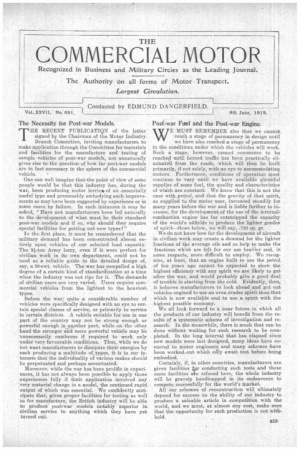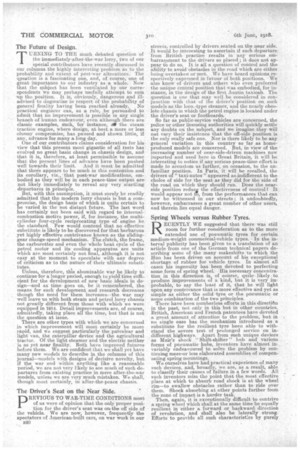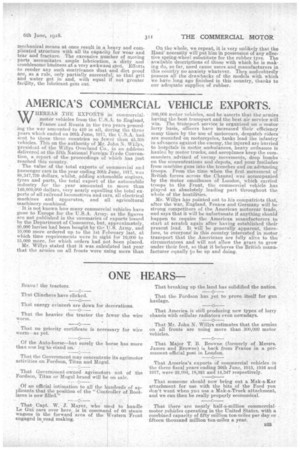• The Necessity for Post-war Models.
Page 1

Page 2

Page 3

If you've noticed an error in this article please click here to report it so we can fix it.
THE RECENT PUBLICATIQN of the letter signed by the Chairman of the Motor Industry Branch Committee, inviting manufacturers to make application through the Committee for materials and facilities for the manufacture and testing of sample vehicles of post-war models, not unnaturally gives rise to the question of how far post-war models are in fact necessary in the sphere of the commercial vehicle.
One can well imagine that the point of view of some people would be that this industry has, during the war, been producing motor lorries of an essentially useful type and presumably embodying such improvements as may have been suggested by experience or in some cases by failure. In such instances it may be asked, "Have not manufacturers been led naturally to the development of what must be their standard post-war models .and if so, why should they require special facilities for getting out new types ?"
In the first place, it must be remembered that the military demand has been concentrated almost entirely upon vehicles of one selected load capacity. The 3A-ton Army lorry, even if it were perfect for civilian work in its own department, could not be used as a reliable guide to the detailed design of, say, a 30-cwt. vehicle. The war has compelled a high degree of a certain kind of standardization at a time when the industry was not ripe for it. The demands of civilian users are very varied. Users require commercial vehicles from the lightest to the heaviest types.
Before the war, quite a considerable number of vehicles were specifically designed with an eye to certain special classes of service, or primarily to service in certain districts. A vehicle suitable for use in one part of the country may not be strong enough or powerful enough in another part, while-on the other hand the stronger and more powerful vehicle may be unnecessarily cumbrous if required to work only under very favourable conditions. Thus, while we do not want manufacturers to dissipate their energies by each producing a multitude of ,types, it is in our interests that the individuality of various makes should be perpetuated and perhaps accentuated.
Moreover, while the war has been prolific in experiences, it has not always been possible to apply those experiences fully if their application involved any very material change in a model, the continued rapid output of which was essential. We confidently anticipate that, given proper facilities for testing as well as for manufacture, the British industry will be able to produce post-war models notably superior in civilian service to anything which they have yet turned out.
Post-war Fuel arid the Post-war Engine.
E MUST REMEMBER also that we cannot reach a stage of permanency in design until we have also reached a stage of permanency in the conditions under which the vehicles will work. Such a stage, however, cannot commence to be reached until horsed traffic has been practically eliminated from the roads, which will then be built primarily, if not solely, with an eye to accommodating motors. Furthermore, conditions of operation must continue to vary until we have available plentiful supplies of some fuel, the quality and characteristics of which are constant. We know that this is not the case with petrol, and that the gravity of that spirit, as supplied -to the motor user, increased steadily for many years before the war and is liable further to increase, for the development of the use of the internalcombustion engine has far outstripped the capacity of the world's oilfields to produce the lighter grades of spirit—those below, we will say, .720 sp. gr.
We do not know how far the development of aircraft in civilian work may create a demand for the lighter fractions of tbe average oils and so help to make the fractions which are left for our use heavier and, in some respects, more difficult to employ. We recognize, at least, that an engine built to use the petrol of ten years ago cannot be expected to show the highest efficiency with any spirit we are likely to get after the war,' and would probably give a good deal of trouble in starting from the cold. Evidently, then, it behoves manufacturers to look ahead and get out vehicles engined to use an even cruder spirit than that which is now available and to use a spirit with the highest passible economy.
We all look forward to .a near future in which all the products of our industry will benefit from the results of a systematic scheme of investigation and research. In the Meanwhile, there is much that can be done without waiting for such research to be completed. In the long interval that has elapsed since new models were last designed, many ideas have occurred to motor engineers and many schemes have been worked,out which otily await test before being embodied.
Certainly, if, in other countries, manufacturers are given facilities laar conducting such tests and these
same facilities ate refused here, the whole industry will be gravely handicapped in its endeavours to conipete successfully for the world's market.
All our schemes of reconstruction will ultimately depend for success on the ability of our industry to produce a saleable article in competition with the world, and we must, at almost any cost, make sure that the opportunity for such production is not withhold.
The Future of Design.
TURNING TO THE much debated question of the immediately-after-the-war lorry, two of our special contributors have recently discussed in mu columns the highly interesting problem as to the probability and extent of post-war alterations. The qeeation is a fascinating one, and, of course, one of great importance to our industry as a whole. Now that the subject has been ventilated by our correspondents we may perhaps usefully attempt to sum. up the position. . It is, obviously, dangerous and illadvised to dogmatise in respect of the probability of general finality having been reached already. No practical engineer can, as a rule, be persuaded to admit that no improvement is possible in any single branch of human endeavour, even although there are classic examples, such, for instance, AP the steam traction engine, where design, at beat a more or less clumsy compromise, has paused and shown little, if any, advance for many a long day. One of our contributors claims consideration for hisview that this present most gigantic of all tests has evolved no great basic change in chassis design, and that it is, therefore, at least permissible to assume that the present lines of advance have been pushed well towards their limit. And it mast be admitted that there appears to be much in this contention and its corollary, viz,,that past-war modifications, embodied as they will be in each peace-time output are not likely immediately to reveal any very startling departures in principle.
But, with this assumption, it must surely be readily admitted that the modern lorry chassis is but a compromise, the design basis of which is quite certain to be varied in the not distant future. The last word has certainly not been said with regard to internalcombustion motive power, if, for instance, the multicylinder four-cycle reciprocating type of engine be the standard. Few would contend that no effective substitute is likely to be discovered for that barbarous yet highly effective contrivance known as the slidinggear change-speed mechanism. The clutch, the frame, the carburetter and even the whole heat cycle of the petrol motor and its cooling apparatus are unite which are most certainly not final, although it is not easy at the moment to speculate with any degree of criticism as to the nature of their ultimate substitutes. Unless, therefore, this abominable war be likely to continue for a longer period, enough to yield time sufficient for the deyeloprnent of new basic ideals in design—and as time goes on, be it remembered, the meeris for such development and research decreases though the need for them increases—the war may well leave us with both steam and petrol lorry chassis not greatly different from those with which we were equipped in 1914. Detail improvements are, of course, admittedly, taking place all the time, but that is not the question at issue.
There are other types with which we are concerned in which improvement will• most certainly be more rapid, and we suggest particularly the paacelcar and light van, the caterpillar device and the agricultural tractor. Of the light steamer and the electric neither is as yet near finality. Both have improved futures hefere them. We are confident that we shall yet have many new models to describe in the columns of this journal—models with designs of decisive novelty, but if the war end within anything like a reasonable period, we are not very likely to see much of such departures from existing practice in mere after-the-war models, unless we are very much mistaken. We shall, though most certainly, in after-the-peace chassis.
The Driver's Seat on the Near Side.
PREVIOUS TO WAR-TIME CONDITIONS most of us were of opinion that the only proper position for the driver's seat was on the off side of the vehicle. We are now, however, frequently the spectators of American-built cars, on war work in our
B20
streets, controlled by drivers. seated on the near side. It would be interesting to ascertain if such departure from British practice results. in any eerious ,embarrassment to the drivers so placed; it does not appear to do so. It is all a question of control and the ability to avoid obstacles in the road which are either being overtaken or met. We have heard opinions respectively expressed in favour of both positions. We also know of drivers and others who even preferred the unique central position that was embodied, for inStance, in the design of the first. Austin taxicab. The question is one that may well be considered in conjunction with that of the driver's position on such models as the loco.-type steamer, and the nearly obsolete chassis in which the petrol engine is located under the driver's. seat OT footboards.
So far as public-service vehicles are concerned, the police or other licensing authorities will quickly settle any doubts on the aubject, and we imagine they will not Vary their insistence that the off-side position is the only really safe one. Nor is there likely to be any general variation in this country so far as homeproduced models are concerned. But, in view of the increasing number of near-side-driven machines now imported and its.ed here in Great Britain, it will be interesting to notice if any serious peace-time effort is made to accustom us further, on occasion, to the unfamiliar position. In Paris, it will be recalled, the drivers of "taxi-autos " appeared as indifferent to the choice of side for the seat as they did for the side of the road on which they should run. Does the nearside position redueg the effectiveness of control? It would-appear not al, from the performances that can now he witnessed in our streets ; it undoubtedly, however, embarrasses a great number of other users, and therein lies equal danger.
Spring Wheels versus Rubber Tyres.
RECENTLY WE suggested that there was still room for further consideration aa to the more extended use . of pneumatic tyres for certain medium-weight commercial-vehicle types. In the interval publicity has been given to a translation of an article from one of the German technical papers describing Some of the many makeshifts to which the Hun has been driven on account of his exceptional shortage of rubber for vehicle tyres. In almost all cases his ingenuity has been devoted to perfecting some form of spring wheel. His necessary concentration in. this direction is, of course, quite likely to produce improvements of a kind, but it is very improbable, to say the least of it, that he will light upon any contrivance that is more effective and yet as simple as either the solid tyre or the pneumatic or some cembination of the two principles.
There have been numberless efforts in this direction in the past, not only in this but in other countries. British, American and French patentees have devoted a great amount of attention to the problem, but in no single case has the mechanism introduced as a substitute for the resilient tyre been able to withstand the severe test of prolonged service on indifferent highways. Apart from such unique devices as Mu'ir's shock " Shift-shifter" hub and various forms of pneumatic hubs, inventors have almost invariably endeavoured to solve the problem by continuing moreeir less elaborated assemblies of compensating spring mountings. We ourselves have had practical experience of many such devices, and, broadly, we are, a-s a result, able to classify their causes of failure in a few words. All such inventors miss the point that the most effective place at which to absorb road shock is at the wheel rim—to swallow obstacles rather than to ride over them. Shock absorbing at other points further from the zone of impact is a harder task.
Then, again, it is exceptionally difficult to contrive a spring wheel which shall at the. same time be equally resilient in .either a, forward or backward direction of revolution, and shall also be laterally strong. Efforts to provide all such characteristles by purely mechanical means at once result.ina heavy and complicated structure with all its capacity for wear and tear and fracture. The excessive number of moving parts necessitates ample lubrication, a dirty and troublesome business at a very awkward spot. Efforts to render any such contrivance dust and dirt proof are as a rule, only partially successful, so that grit and water get in and; with equal if not greater facility, the lubricant gets out. On the whole, we repeat, it is very unlikely that the Rani' neeesSity will put him in possession of any effective spring-wheel substitute for the rubber tyre. The available descriptions of those with which he is making do, so far, need cause users and manufacturers in this country no anxiety whatever. They undoubtedly possess all the drawbacks of the models with which. we have long ago finished in this country, thanks to our adequate supplies of rubber.






















